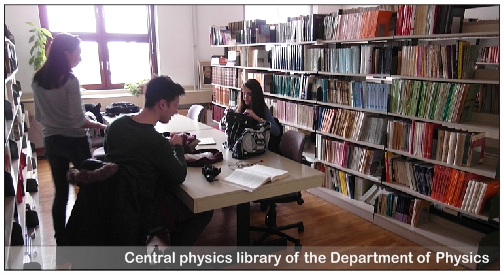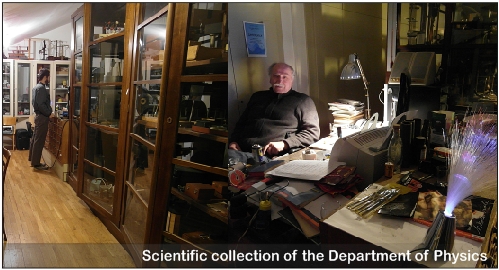
Departmental teaching facilities include 2 lecture halls, 4 medium classrooms, library with reading rooms, 2 computer labs, 7 student laboratory (practicum) classrooms, 3 seminar rooms, workshop and a dozen of advanced research laboratories.

Departmental teaching facilities include 2 lecture halls, 4 medium classrooms, library with reading rooms, 2 computer labs, 7 student laboratory (practicum) classrooms, 3 seminar rooms, workshop and a dozen of advanced research laboratories.
Central Library for Physics belongs to a group of university libraries whose purpose is to meet the needs of teaching and study programs of all levels and courses at the Department of Physics. It makes part of the group of research libraries whose purpose is to enable scientific research and the acquisition of the scientific title.
Central Library for Physics was estabished in 1990 at the session of the Faculty of Science of the University of Zagreb, by joining three departmental libraries. One of these departmental libraries has been established as early as 1876 and, as its successor, Central Physics Library maintains long tradition and preserves its valuable fund for future generations. Additionally, the library strives to serve and satisfy every user with providing requested information.

Central Library for Physics has been relocated in 1991 from Marulić Square to new premises at 32 Bijenička Street, where newly planned science complex was to be constructed. The Library itself has joint the funds of the following departmental libraries:
1. Library of Physics Division (founded in 1876),
2. Library of the Division for Theoretical Physics (founded in 1920) and
3. Library of the Division for History, Sociology and Philosophy of Science, founded in 1961, at the initiative of academician Ivan Supek.
The library is in the possession of about 15,000 books and 500 journals, mostly in the field of physics, and may be categorized as a Special Library.
The library has preserved a large number of valuable books, some even from the Jesuit Academy in Zagreb (the oldest dating in 1658), as well as large number of valuable magazines. The oldest newspaper is dating back to 1799, Annalen der Physik, released just nine years after the first specialized magazine of physics.
The library has received many donations of books by Stanko Hondl, prof. Dr. M. Sikirica, Kathleen Wilkes, Gaja Alaga, Davor Dužević, Zlatko Janković, Olga Verinić, Dubravka Tadić, Mladen Paić, Krešimir Franjić and others.
READING ROOM
Reading room is composed of four areas: two identical rooms (with reading and storage room) for scientific-teaching staff and students, a room for the staff of the library with textbooks, hallway with information desk, copy machine and storage. The library has a total of 1310 meters of shelves, of which around 900 meters are covered with books (publications), and 100 meters of inclined shelves serve for exposure of magazines and journals. The total area of the library is 350 m2.
After its relocation to the building at the Wilson Square, the Physics Cabinet has started with collecting devices and demonstration experiments. This collection nowadays consists of few thousands of devices and books, of which many have priceless value. During various periods of the existence of the Physics Division, procurement of equipment and instruments for teaching physics was largely conditioned by the research preferences of professors who were in charge of the collection. Collection itself has corresponded to recent discoveries in the field of physics. Thus, only six months after Röntgen’s discovery, on May 30, 1896, was purchased the first X-ray Geissler tube for 30 German marks (Rühmkorff's inductor with two switches is still in use as a source of high voltage, and it was purchased in 1876). With the discovery of electromagnetic waves, equipment for Hertz experiments of transmission distance was purchased in 1897 (consisting of receiving and transmitting antenna with dipoles, coherer and polarization gratings). Apparatus for experiments with high-frequency currents were acquired after the release of Tesla's patents, of which it should be singled out Tesla’s transformer with a mercury switch. Interest of some members of Department of Physics for the music and sound is also evident in the well-equipped collection of tuning forks, instruments and other devices for the study of sound. Dvořák's resonators stand out in the collection in this regard.
